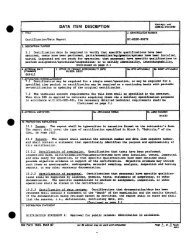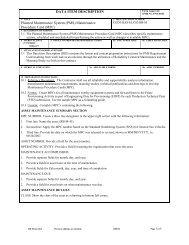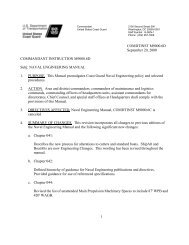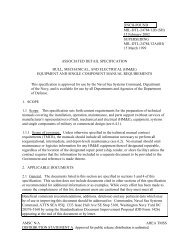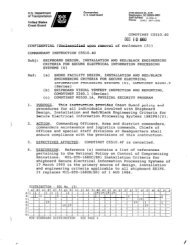comdtinst m2400.1f - US Coast Guard Response Boat-Medium
comdtinst m2400.1f - US Coast Guard Response Boat-Medium
comdtinst m2400.1f - US Coast Guard Response Boat-Medium
You also want an ePaper? Increase the reach of your titles
YUMPU automatically turns print PDFs into web optimized ePapers that Google loves.
2.B.2. c. Transmission. With the exception of distress communications<br />
and urgency and safety signals, no transmission will be made on<br />
2183.4 (2182) kHz for three minutes twice each hour beginning<br />
at HX00 and HX + 30 UTC.<br />
d. Calling. Call radio stations other than <strong>Coast</strong> <strong>Guard</strong> when other<br />
means of communications are not available or not desired. (After<br />
a preliminary call to establish communications, when practicable,<br />
units shall shift to an appropriate working frequency.)<br />
e. Working Frequencies. Call <strong>Coast</strong> <strong>Guard</strong> units for the purpose of<br />
establishing communications and then shift to an appropriate<br />
working frequency for the passing of traffic. In districts<br />
where a guard is maintained on a working frequency, units<br />
should call and work on those channels.<br />
f. Broadcasts. Announce Maritime Safety Information Broadcasts.<br />
3. a. Carrier Frequencies 4125 and 6215 kHz. The carrier frequencies<br />
4125 and 6215 kHz are used to supplement the carrier frequency<br />
2182 kHz for distress and safety purposes and for call and<br />
reply. These frequencies are also used for distress and safety<br />
traffic by radiotelephony.<br />
b. Carrier Frequency 4125 kHz. The carrier frequency 4125 kHz may be<br />
used by aircraft stations to communicate with stations of the<br />
maritime mobile service for distress and safety purposes.<br />
4. 121.5 MHz: This frequency is the VHF-AM aeronautical distress<br />
frequency, also used by aircraft Emergency Locator Transmitter<br />
(ELT's), ship Class A, B, S and Category I EPIRB's, and<br />
COSPAS-SARSAT Search and Rescue Satellite-Aided Tracking system<br />
distress alerting and locating. <strong>Coast</strong> <strong>Guard</strong> units may use 121.5 MHz<br />
to transmit (from aircraft, or using an EPIRB), or receive distress<br />
calls and messages. Class A EPIRB's are automatically activated,<br />
float free devices, and Class B and S EPIRB's are manually activated<br />
devices. Class S EPRIB's, intended for survival craft, are designed<br />
to float.<br />
5. 156.8 MHz: The VHF-FM frequency 156.8 MHz is the International<br />
distress, safety and calling voice frequency in the 156-162 MHz band<br />
for the maritime mobile service. The frequency may be used by ship<br />
radiotelephone stations to request assistance from maritime services.<br />
It may be used for distress calls and distress traffic and for urgency<br />
And safety signals and urgency and safety messages. In addition<br />
it may be used for call and reply, for signals preparatory to traffic,<br />
and by coast radiotelephone stations to announce transmissions, on<br />
other frequencies, which are of general interest to ship stations<br />
including ordinary weather and hydrographic information. It is also<br />
used by Class C EPIRB's for distress alerting purpose. 156.8 MHz<br />
must not be used for the transmission of any traffic other than<br />
specified above. <strong>Coast</strong> <strong>Guard</strong> units may use 156.8 MHz as follows:<br />
a. Distress Calls. Transmit and receive distress calls<br />
and distress messages.<br />
2-3





